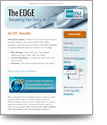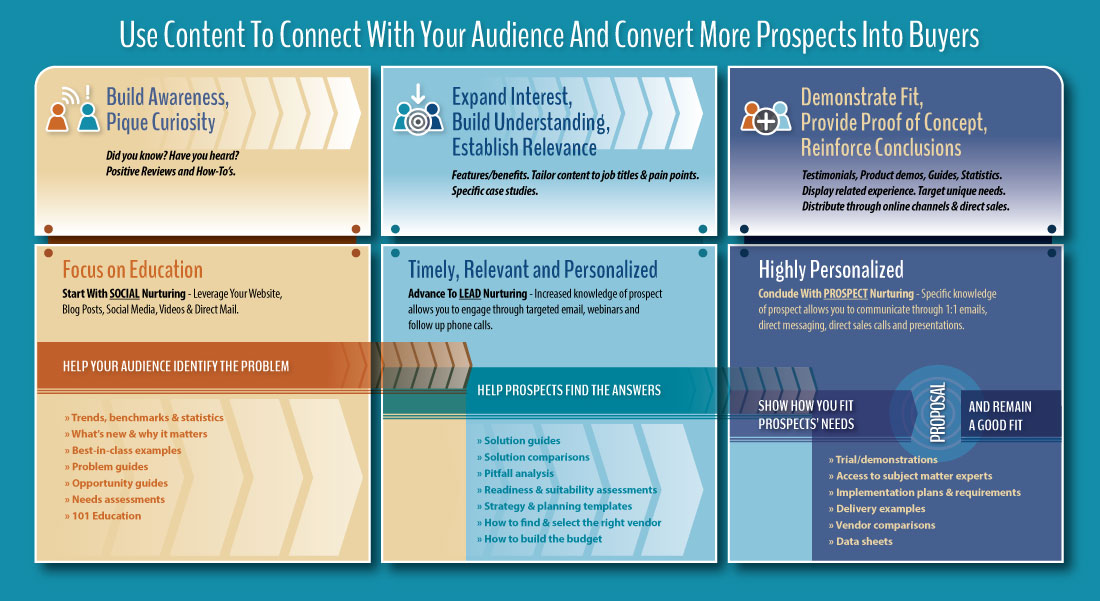
The statistics are overwhelming. Regardless of the channel. With or without a direct sales force. Prospects aren't ready to buy. At least not right away. In fact, whether it's online from your website or offline at an event, only 10 -15% of the leads you generate are ready to buy now. Another 20 - 30% will never buy.
The others? Most purchase within two years. And without a lead nurturing plan in place, they will likely make that purchase from a competitor.
Here's what you can do to get your fair share.
Develop A Lead Nurturing Plan
Have you heard the sales adage, "50% of sales success is just showing up?" Or, "when you show up with a plan and effectively execute it each day, the odds of closing a sale dramatically improve?" It's the same with lead nurturing. Almost any lead follow up is better than none. However, an organized lead nurturing plan that's executed consistently yields the most significant benefits.
Here's a common lead follow up plan. Get a lead. Give it to sales. Otherwise known as the just showing up plan.
According to Sirius Decisions, 80% of leads generated by marketing get ignored by sales. Leads that don’t offer your sales team a short term opportunity get little time or attention. Only once you've identified prospects that are truly interested in your capabilities should they go to sales for follow up.
What’s Your Goal?
Is your goal to convert the small percentage of prospects that are sales ready and not worry about the others? If so, you don’t need a nurturing program. However, turning more prospects into buyers takes a lead nurturing plan. Executing an effective program will improve your marketing return on investment.
Start By Segmenting Your Prospects
Nurturing means encouraging growth and development. A regular follow up email to learn where a prospect stands in the purchasing process isn’t nurturing. It serves your needs but not the prospect. They want to understanding your industry, your capabilities and the benefits you provide.
We recently dined at a restaurant for the first time. As the waiter came to our table and introduced himself, he found that it was our first visit. He proceeded to educate us on the type of food they served, their preparations and specialties. After we ordered drinks he provided us more detail on the menu and the dishes that set them apart. He also learned our preferences and suggested items that best fit our tastes.
You may not serve food but an effective nurturing plan follows a similar path. Understanding your prospects position in their purchasing journey is the first step.
The waiter quickly understood we were a first time guest. He understood that education about the restaurant and their food specialties would encourage additional questions and help us reach a food choice that best satisfied our tastes.
Buyers go through various stages before they are ready to make a purchase. The type of information that's most relevant to your audience depends on that stage. So, before you can set up an effective nurturing campaign, segment your prospects.
In categories such as:
- Top of the funnel
- Middle of the funnel
- Bottom of the funnel
- Sales ready
Top Of The Funnel
Whether the prospect first interacted with you online or in person, they are early in the discovery phase. These are the prospects that are just getting to know you. Learning about your industry, the big picture benefits of solutions like yours and how those solutions might work in their operation are important.
Educational information including industry trends, statistics and industry best practices are the type of information this group finds useful.
Middle Of The Funnel
A prospect advances to the middle of the funnel when they have shown interest in you. That could be from website visits, white paper downloads, email interaction, phone conversations, in-person meetings and more. Learning about your prospects allows you to target your messages.
The waiter listened to our food preferences which guided his follow up.
As your audience gains a greater understanding of big picture benefits they are ready to drill down to understand how the solution actually works. This is where how-to information, solution comparisons and information tailored to their pain points are helpful.
Bottom Of The Funnel
Bottom of the funnel prospects are nearing the point of choosing a vendor. Webinars, demonstrations, case studies, samples, facility tours and meetings with subject matter experts can assist their decision making.
Based on what our waiter learned about us, he suggested items that complemented our entree selections and lead to a better dining experience.
Sales Ready
Once a prospect advances to this level, the odds they will purchase have increased substantially. Your sales team will be fighting for leads like these!
These prospects are ready to purchase from you or your competitor. The entire sequence of communications from education to understand and then demonstrating how your capabilities fit will position you to compete for this business.
Our waiter used these same steps. We understood the specialties and he understood our tastes. He recommended appetizers, entrees and sides that fit our tastes. He built his tip and cemented a return visit from our family at a later date.
Companies that excel at lead nurturing generate 50% more sales ready leads. And these nurtured leads make 47% larger purchases.
Marketing Automation
With more than a few leads to nurture, effective follow up is challenging to execute. However, marketing automation systems allow you to execute a lead nurturing plan that's impossible to do manually including:
- Understand a prospects digital interaction with you
- Automatically score the interactions
- Seamlessly move a prospect into a different funnel category based on the score
- Automatically trigger information to a prospect that is relevant to the buying stage they are in
- Provide reports on sales ready leads
Companies such as Act-On, Marketo, HubSpot and many others provide solutions that will help you effectively execute a nurturing program.
Check out how Marketing Automation can assist you.A lead nurturing plan elevates the return on your marketing investment. It encourages more prospects to learn about your company and your solutions. If you are investing in lead generation, get the most out of your investment and improve your bottom line.



 Insight Delivered Directly to You Interesting topics, great offers and free marketing tools.
Insight Delivered Directly to You Interesting topics, great offers and free marketing tools.

